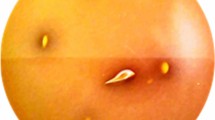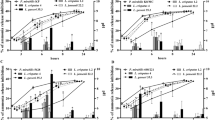Abstract
Hyperoxaluria is a risk factor for renal stones. It appears to be sustained by increased dietary load or increased intestinal absorption. The aim of this study was to evaluate whether oral administration of lactobacilli could prevent urolithiasis in stone-forming rats. Oxalate-degrading activities of lactobacilli were evaluated by measuring the oxalate level in a culture medium after inoculation with lactobacilli. Only the strains of Lactobacillus having oxalate-degrading activity were used. Sprague–Dawley rats were fed a powdered standard diet containing 3% sodium oxalate and/or received 100 mg/kg of celecoxib for the first 8 days by gavage, before or after the beginning of this experiment (groups with previous treatment or with co-treatment). Rats were sacrificed after 4 weeks and kidneys were harvested for the assay of crystal formation under a dissecting microscope. Twenty-four-hour urine collections were performed before kidney harvest. Only two strains, Lactobacillus casei HY2743 and L. casei HY7201 out of 31 strains of Lactobacillus were able to degrade oxalate. In both groups of co-treatment and previous treatment with L. casei HY2743 and L. casei HY7201, urine oxalate excretion decreased compared to the group without lactobacilli. The dissecting microscope examination of kidneys in the rats in two previous treatment groups and the co-treatment group with L. casei HY7201 showed less abundant crystals than control groups. Our results show that lactobacilli may be used as a potential therapeutic strategy in the prevention of urinary stones.



Similar content being viewed by others
References
Kim H, Jo MK, Kwak C, Park SK, Yoo KY, Kang D, Lee C (2002) Prevalence and epidemiologic characteristics of urolithiasis in Seoul, Korea. Urology 59:517
Uribarri J, Oh MS, Carroll HJ (1989) The first kidney stone. Ann Intern Med 111:1006
Byeon SS, Kim HH, Kim SH (1996) Analysis of the urinary stone components using chemical analysis method. Korean J Urol 37:179
von Unruh GE, Voss S, Sauerbruch T, Hesse A (2003) Reference range for gastrointestinal oxalate absorption measured with a standardized [13C2]oxalate absorption test. J Urol 169:687
Chadwick VS, Modha K, Dowling RH (1973) Mechanism for hyperoxaluria in patients with ileal dysfunction. N Engl J Med 289:172
Smith LH, Fromm H, Hofmann AF (1972) Acquired hyperoxaluria, nephrolithiasis, and intestinal disease. Description of a syndrome. N Engl J Med 286:1371
Allison MJ, Dawson KA, Mayberry WR, Foss JG (1985) Oxalobacter formigenes gen. nov., sp. nov.: oxalate-degrading anaerobes that inhabit the gastrointestinal tract. Arch Microbiol 141:1
Kwak C, Jeong BC, Lee JH, Kim HK, Kim EC, Kim HH (2001) Molecular identification of Oxalobacter formigenes with the polymerase chain reaction in fresh or frozen fecal samples. BJU Int 88:627
Hokama S, Honma Y, Toma C, Ogawa Y (2000) Oxalate-degrading Enterococcus faecalis. Microbiol Immunol 44:235
Hida M, Aiba Y, Sawamura S, Suzuki N, Satoh T, Koga Y (1996) Inhibition of the accumulation of uremic toxins on the blood and their precursors in the feces after oral administration of Lebenin, a lactic acid bacteria preparation, to uremic patients undergoing hemodialysis. Nephron 74:349
Dunn SR, Simenhoff ML, Ahmed KE (1998) Effect of oral administration of freeze-dried Lactobacillus acidophilus on small bowel bacterial overgrowth in patients with end stage kidney disease: reducing uremic toxins and improving nutrition. Int Dairy J 8:545
Campieri C, Campieri M, Bertuzzi V, Swennen E, Matteuzzi D, Matteuzzi D, Stefoni S, Pirovano F, Centi C, Ulisse S, Famularo G, De Simone C (2001) Reduction of oxaluria after an oral course of lactic acid bacteria at high concentration. Kidney Int 60:1097
Jeong BC, Park MY, Kwak C, Kim BS, Kim JI, Kim HH (2005) An animal model of calcium oxalate urolithiasis based on a cyclooxygenase 2 selective inhibitor. Urol Res 33:453
Barber HM, Gallimore EJ (1940) The metabolism of oxalic acid in the animal body. Biochem J 34:144
Allison MJ, Cook HM, Milne DB, Gallagher S, Clayman RV (1986) Oxalate degradation by gastrointestinal bacteria from humans. J Nutr 116:455
Kumar S, Sigmon D, Miller T, Carpenter B, Khan S, Malhotra R, Scheid C, Menon M (1991) A new model of nephrolithiasis involving tubular dysfunction/injury. J Urol 146:1384
Allison M, Daniel SL, Cormick NA (1995) Oxalate degrading bacteria. In: Kahn SR (eds) Calcium oxalate in biological systems. CRC, Boca Raton, pp 131–169
Sidhu H, Ogden SD, Lung HY, Luttge BG, Baetz AL, Peck AB (1997) DNA sequencing and expression of the formyl coenzyme A transferase gene, frc, from Oxalobacter formigenes. J Bacteriol 179:3378
Sidhu H, Hoppe B, Hesse A, Tenbrock K, Bromme S, Rietschel E, Peck AB (1998) Absence of Oxalobacter formigenes in cystic fibrosis patients: a risk factor for hyperoxaluria. Lancet 352:1026
Kwak C, Oh JE, Kim HK, Choi MS, Kim EC, Kim HH (2003) Isolation and purification of the oxalate-degrading bacterium Oxalobacter formigenes in human feces. Korean J Urol 44:785
Acknowledgment
This work was supported by the Clinical Research Institute, Seoul National University Hospital (06-2002-028).
Author information
Authors and Affiliations
Corresponding author
Rights and permissions
About this article
Cite this article
Kwak, C., Jeong, B.C., Ku, J.H. et al. Prevention of nephrolithiasis by Lactobacillus in stone-forming rats: a preliminary study. Urol Res 34, 265–270 (2006). https://doi.org/10.1007/s00240-006-0054-4
Received:
Accepted:
Published:
Issue Date:
DOI: https://doi.org/10.1007/s00240-006-0054-4




